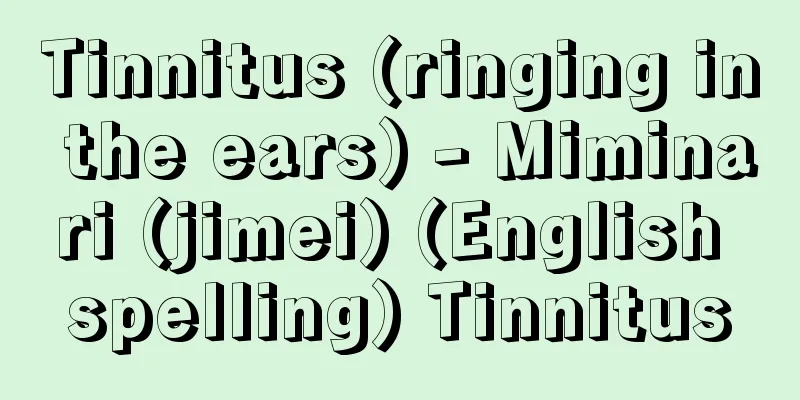Tinnitus (ringing in the ears) - Miminari (jimei) (English spelling) Tinnitus

What is tinnitus? Tinnitus is a condition where you hear sounds even though there are no sounds outside. In reality, the majority of tinnitus cases are subjective, so we will start by discussing subjective tinnitus. Subjective tinnitusThe mechanism by which subjective tinnitus (hereafter simply tinnitus) occurs is unclear, but it is speculated to occur when the hearing nerves are activated somewhere along the hearing pathway from the inner ear to the brain, regardless of external sound input. Tinnitus is generally felt more loudly at night or early in the morning when the outside world is quiet. Tinnitus can occur with a variety of illnesses. The most common are: Because tinnitus is subjective, it is difficult to accurately measure its nature and intensity; however, by using tinnitus testing equipment to generate sounds of various pitches and intensities and comparing them to tinnitus sounds, it is possible to give it a numerical evaluation to some extent. Treatment of subjective tinnitusWhen the underlying disease is clear, treating that disease will be the treatment for tinnitus. However, in many cases the cause of tinnitus is unknown, and various treatments are attempted. The most commonly used medications are drugs that improve blood circulation to the inner ear and brain, drugs that relax muscles, and tranquilizers. Other options include intravenous injection of local anesthetics. Tinnitus is often caused by mental tension or stress, so a psychological approach is also important. When real sounds come in from the outside, tinnitus becomes relatively difficult to recognize (masking effect), so you can alleviate tinnitus by enjoying your favorite music or radio. There are also devices called maskers, which are similar to hearing aids and emit sounds such as noise that continuously mask tinnitus. In addition, it is said that about 80% of patients who have tinnitus due to severe hearing loss and have undergone cochlear implant surgery experience relief from tinnitus while using the cochlear implant. Objective tinnitusNext, I will talk about objective tinnitus. When a patient has objective tinnitus, if the doctor connects the patient's ear to the doctor's ear with a tube like that used for a stethoscope, in most cases the doctor can hear the tinnitus that the patient is hearing. There are two types of objective tinnitus: intermittent and continuous. Intermittent sounds can often be described as a tapping or popping sound, and are caused by the muscles around the Eustachian tube or When the sound is constant, it may be heard as noise caused by blood flowing through the large veins and arteries around the ear. Treatment of objective tinnitusTreatment is determined according to the cause. For example, if it is a muscle spasm, drugs that relax the muscles may be tried, or the tendons of the muscles that attach to the ossicles may be severed. However, simply finding out the cause of this strange tinnitus can ease anxiety, and there are also options to just wait and see how it progresses. Peaceful coexistence with tinnitus Tinnitus itself is not life-threatening or painful. However, Even if tinnitus is not cured completely in the end, it is common to gradually come to a state of "peaceful coexistence" with tinnitus over time, where the patient feels that "the tinnitus is there, but it doesn't bother me much." This may seem negative, but for an intractable symptom like tinnitus, one solution is to take the time to reach this kind of accepting mindset. Yasushi Naito Source: Houken “Sixth Edition Family Medicine Encyclopedia” Information about the Sixth Edition Family Medicine Encyclopedia |
耳鳴りとは 耳鳴りとは、外で音がしていないのに音が聞こえる状態ですが、現実には音がない 現実的には自覚的耳鳴が大多数なので、まず自覚的耳鳴から話を進めます。 自覚的耳鳴自覚的耳鳴(以下、単に耳鳴り)が起こる仕組みははっきりしていませんが、内耳から脳に至る聴覚経路のどこかで、外からの音入力に関係なく聞こえの神経が活性化されることで生じると推測されます。また耳鳴りは、外界が静かになる夜や早朝に大きく感じることが一般的です。 耳鳴りは、さまざまな病気に伴って起こります。代表的なものは 耳鳴りは主観的なものなので、その性質や強さを正確に測るのは難しいのですが、耳鳴検査の器械を用いていろいろな高さ、強さの音を発生させ、それと聞き比べることで、ある程度数値として評価することができます。 自覚的耳鳴の治療原因となる病気がはっきりしている時には、その病気を治療することが耳鳴りの治療になります。しかし、多くの耳鳴りは原因不明で、いろいろな治療が試みられます。 よく用いられるのは、内耳や脳の血液循環を改善する薬、筋肉の緊張を和らげる薬、精神安定薬などの薬物療法です。そのほか、局所麻酔薬の静脈注射、 耳鳴りの背景に精神的緊張やストレスが存在することも多いので、心理的なアプローチも重要です。外から現実の音が入ってくると、相対的に耳鳴りが認知しにくくなること(マスキング効果)を利用して、好きな音楽やラジオなどを楽しむことで耳鳴りを緩和することができます。マスカーといって、補聴器のような器具で持続的に雑音など耳鳴りをマスクするような音を出す機器もあります。また、高度難聴に伴う耳鳴りがある方で人工内耳埋め込み手術を受けた患者さんのうち、約80%において、人工内耳使用中に耳鳴りが軽減するとされています。 他覚的耳鳴次に、他覚的耳鳴について述べます。他覚的耳鳴がある場合、実際に患者さんの耳と医師の耳を聴診器で使うようなチューブでつないでみると、ほとんどの場合、患者さんが聞いている耳鳴りを医師が聞くことができます。他覚的耳鳴には、間欠的なものと持続的なものがあります。 間欠的なものには、コツコツとかプツプツなどと表現できる音が多く、耳管周辺の筋肉や 音が持続的な場合では、耳周辺の大きな静脈や動脈内を血液が流れる時に生じる雑音が聞こえる例があります。 他覚的耳鳴の治療治療は、それぞれの原因に応じて考えます。たとえば筋肉のけいれんなら、筋肉の緊張をとるような薬物を試みたり、耳小骨についている筋肉の腱を切断することもあります。しかし、この奇妙な耳鳴りの原因が明らかになるだけでも不安が解消され、そのまま経過をみてゆく方法もあります。 耳鳴りとの平和共存 耳鳴りそのものは、生命の危険を伴うものでも痛みを生じるものでもありません。しかし、 また、たとえ最終的に耳鳴りが完全に治らなくても、時間がたつにつれて次第に「耳鳴りはしているが、あまり気にならない」というように、耳鳴りと「平和共存」できるようになるのが一般的です。消極的と思われるかもしれませんが、耳鳴りのように難治性の症状に対しては、時間をかけてこのような受容的考え方にたどり着くのもひとつの解決法なのです。 内藤 泰 出典 法研「六訂版 家庭医学大全科」六訂版 家庭医学大全科について 情報 |
Recommend
Enkyu Manor Reorganization Order
...In this way, government property became taxes ...
life mask
...The face of the deceased is cast using plaster...
Calyx
A calyx is the outer ring of the perianth (hetero...
hire base
…On the other hand, since ship expenses are fixed...
Kaburaki Kiyokata
Born: August 31, 1878 in Tokyo [Died] March 2, 197...
vested rights
…An 1819 decision is often cited as an example of...
Amorous woman - Amorous woman
Ihara Saikaku's Ukiyo-zoshi. Published in Jun...
Haikai Mediocre Form - The Form of a Poetic Man
A collection of haikai renku (linked verse), compi...
Linum
...A crop from which fiber is extracted from the ...
Polignac, JAAMde (English spelling) PolignacJAAMde
...In 1824, when the leader of the Ultras, Count ...
Ultrastructure - Choubi Saikozo
This refers to the hyperfine splitting of spectra...
Orthogenesis
When fossils belonging to a certain phylogenetic ...
Cowboy and Weaver Girl
...It is said that when the meeting took place, t...
Ranran - Ranran
1647-93 (4th year of Shoho - 6th year of Genroku) ...
Karen
… Various microtopographies are carved into limes...





![Maeander (English spelling) [Latin]](/upload/images/67ccfdd729807.webp)



